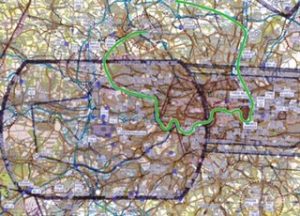Flying the London Helicopter Lanes for the very first time can be a daunting prospect for many helicopter pilots. It can be relatively complex and there are some unique aspects to it which make it both challenging and thrilling. If you’re planning on flying through the London Helicopter Lanes for the first time, here are some notes that will help you. Above all, we do not recommend flying it alone the first time. Take along someone with experience of the routes and procedures which can offer assistance if you feel that the workload is getting a little too intense.
The London Helicopter Lanes can be intimidating, sharing airspace with airliners above you, Police and HEMS alongside you and military helicopters such as Chinooks all around you. However if you prepare thoroughly there is no reason why any helicopter pilot cannot fly the routes and enjoy the amazing views of central London.
Disclaimer – This is intended as casual guidance only and shouldn’t be used as a sole means for attempting to fly the London Heli Lanes. For more accurate information please see Pooleys Flight Guide, the London Heli Routes CAA Chart and the AIP.
The video here was shot in June 2019 and shows Oli Nicholls guiding pilot Josh through his first experience of the London helicopter lane system. Read Oli’s notes below for more help on this fascinating location to fly helicopters
Use GPS for Navigation – It’s pretty much essential to use GPS. It’s not cheating, the CAA chart for the area is huge, so it isn’t really that sensible to use it when you have modern alternatives such as Runway HD to use. You will have far more time to spend looking outside for opposing traffic and it is a huge help.
Of course, you should also have the paper chart folder appropriately on standby should you have a GPS failure.
Planning is important. Using the charts look carefully at the route you want to fly. You will see that the routes span across Heathrow’s and London City Airport’s Class D Controlled Airspace. Like always when you transit any airspace you want to hear the word ‘cleared’ which should be read back along with the details of your clearance. Just because these routes are depicted on the chart does not mean that we have the right to fly them without speaking to ATC.

Make Notes of Important Points – Write down the specific names of the entry and exit points that you wish to route via such as ‘Northwood’ and ‘Isle of Dogs’ and remember them to tell Heathrow Radar. Also note the name of the route you wish to follow. In this example we will use H9, H10 and H4. These are written next to the dashed line you will follow. You will also see an altitude next to the route name. These altitudes are maximum altitudes to be flown and they change as you progress along your entire route. Take care not to fly the same altitude for too long into a section where you must be lower. This is because of Heathrow’s airspace above you. For example as you progress south from Northwood on H9 the maximum altitude you are allowed to be at reduces. This is because Heathrow’s approach path is getting closer. You might think ‘surely its just easier to fly at the lowest published altitude on the route and you can’t go wrong?’ This isn’t the case, you want as much altitude as possible without exceeding the maximum in case anything went wrong; in which case you would be able to glide safely to an open space.
Listen Carefully to ATC and be Concise – After establishing contact with Heathrow with some standard phraseology such as “Heathrow Radar, G-OBSM” don’t be surprised if they ask you to standby. Once they are ready for your message it might go something like this: “G-OBSM, R44, 2 on board, Walton Wood to Redhill, request Northwood to Isle of Dogs routing H9, H10, H4”.
Don’t rush the call. Speak clearly at a normal pace so the controllers fully hear and understand what you want to do. With any luck you may hear something like: “G-OBSM, cleared to enter at Northwood routing H9, H10 and H4, standard operating altitudes, clearance limit is Barnes”
Understand the Reporting Points – Barnes is just a reporting point which is visible on the charts. There are many. It’s important you read back the clearance in full so they know you have understood your clearance limit. Some reporting points are compulsory while others aren’t. Reporting points with an ‘H’ indicate where holding may be required. Standard operating altitudes means fly in accordance with the maximum altitudes published on the charts. This saves the controller having to keep addressing you with a new altitude every couple of minutes.
Be Prepared to Hold – The controllers often do their best to ensure you can continue without unnecessary delays and can change the clearance limit as you go by saying “Clearance limit at Barnes cancelled, continue H4 hold west of London Bridge” meaning exactly that. Repeat back in full. If you find yourself having to hold then make a steady but tight turn until cleared further.
Don’t be surprised if you are asked to change frequency to London City Airport or even London Heliport, which means having the frequencies on hand and listening carefully.
Flying the London Helicopter Lanes is a very fulfilling experience and once you understand the procedures it isn’t as stressful as it first appears. If you fly the routes regularly, then it would quickly become second nature.
Other tips:
Ring ahead. Call 023 8040 1110. That’s the Heathrow Zone Terminal Control. Let them know what you intend to do. Giving prior notice helps everyone coordinate more effectively.
Make use of the NATS pre-notification tool which informs controllers of your intention to transit controlled airspace in advance of your initial radio call.
Leave a Reply